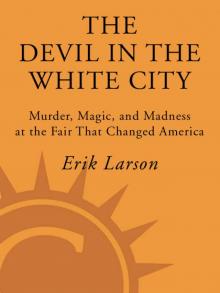- Home
- Erik Larson
Isaac's Storm: A Man, a Time, and the Deadliest Hurricane in History
Isaac's Storm: A Man, a Time, and the Deadliest Hurricane in History Read online
Acclaim for ERIK LARSON’s
ISAAC’S STORM
“Masterful.…A thoroughly engrossing account of the catastophe.”
——The News & Observer (Raleigh)
“A terrifying account of the storm’s wrath.”
—The Seattle Times/Post-Intelligencer
“Larson’s vivid detail and storytelling ability go beyond our fascination with bizarre weather and show how natural disasters can change the course of history.”
—The Hartford Courant
“Richly imagined and prodigiously researched, [Isaac’s Storm] pulls readers into the eye of the hurricane.” —
—The New York Times
“This brilliant exploration of the hurricane’s deadly force is set against the human drama of Isaac Monroe Cline.… Long after you lift your eyes from the final page, this book will bring you back to its portraits of a city under siege, and the storm’s survivors and victims.”
—The Times-Picayune
“Drawing from public records and the personal accounts of survivors, Larson tracks in vivid detail both the path of the hurricane and the trajectory of Isaac Cline’s carrer.”
—The Atlanta Journal-Constitution
“Larson offers Dantesque images of trees, street lamps, houses and furnishings being turned into projectiles … of wind-whipped walls of water pressing the life out of entire city blocks.”
—The Plain Dealer
“In all the books about disasters, few have assembled so many nuanced details into the kind of flood that Larson releases when the storm surges.”
—San Francisco Chronicle
Also by ERIK LARSON
The Naked Consumer
Lethal Passage
ERIK LARSON
ISAAC’S STORM
Erik Larson, a contributor to Time magazine, is the author of The Naked Consumer and Lethal Passage. His work has appeared in The Atlantic Monthly, Harper’s, The New Yorker, and other national magazines. He lives in Seattle.
For Chris, Kristen, Lauren, and Erin
Contents
Cover
Other Books by This Author
About the Author
Title Page
Dedication
Atlantic Ocean Map
Galveston Map
The Beach: September 8, 1900
I: The Law of Storms
II: The Serpent’s Coil
III: Spectacle
IV: Cataclysm
V: Strange News
VI: Haunted
Notes
Sources
Acknowledgments
Excerpt from In the Garden of Beasts
Copyright
TELEGRAM
Washington, D.C.
Sept. 9, 1900
To: Manager, Western Union
Houston, Texas
Do you hear anything about Galveston?
Willis L. Moore,
Chief, U.S. Weather Bureau
THE BEACH
September 8, 1900
THROUGHOUT THE NIGHT of Friday, September 7, 1900, Isaac Monroe Cline found himself waking to a persistent sense of something gone wrong. It was the kind of feeling parents often experienced and one that no doubt had come to him when each of his three daughters was a baby. Each would cry, of course, and often for astounding lengths of time, tearing a seam not just through the Cline house but also, in that day of open windows and unlocked doors, through the dew-sequined peace of his entire neighborhood. On some nights, however, the children cried only long enough to wake him, and he would lie there heart-struck, wondering what had brought him back to the world at such an unaccustomed hour. Tonight that feeling returned.
Most other nights, Isaac slept soundly. He was a creature of the last turning of the centuries when sleep seemed to come more easily. Things were clear to him. He was loyal, a believer in dignity, honor, and effort. He taught Sunday school. He paid cash, a fact noted in a directory published by the Giles Mercantile Agency and meant to be held in strictest confidence. The small red book fit into a vest pocket and listed nearly all Galveston’s established citizens—its police officers, bankers, waiters, clerics, tobacconists, undertakers, tycoons, and shipping agents—and rated them for credit-worthiness, basing this appraisal on secret reports filed anonymously by friends and enemies. An asterisk beside a name meant trouble, “Inquire at Office,” and marred the fiscal reputations of such people as Joe Amando, tamale vendor; Noah Allen, attorney; Ida Cherry, widow; and August Rollfing, housepainter. Isaac Cline got the highest rating, a “B,” for “Pays Well, Worthy of Credit.” In November of 1893, two years after Isaac arrived in Galveston to open the Texas Section of the new U.S. Weather Bureau, a government inspector wrote: “I suppose there is not a man in the Service on Station Duty who does more real work than he.… He takes a remarkable degree of interest in his work, and has a great pride in making his station one of the best and most important in the country, as it is now.”
Upon first meeting Isaac, men found him to be modest and self-effacing, but those who came to know him well saw a hardness and confidence that verged on conceit. A New Orleans photographer captured this aspect in a photograph that is so good, with so much attention to the geometries of composition and light, it could be a portrait in oil. The background is black; Isaac’s suit is black. His shirt is the color of bleached bone. He has a mustache and goatee and wears a straw hat, not the rigid cake-plate variety, but one with a sweeping scimitar brim that imparts to him the look of a French painter or riverboat gambler. A darkness suffuses the photograph. The brim shadows the top of his face. His eyes gleam from the darkness. Most striking is the careful positioning of his hands. His right rests in his lap, gripping what could be a pair of gloves. His left is positioned in midair so that the diamond on his pinkie sparks with the intensity of a star.
There is a secret embedded in this photograph. For now, however, suffice it to say the portrait suggests vanity, that Isaac was aware of himself and how he moved through the day, and saw himself as something bigger than a mere recorder of rainfall and temperature. He was a scientist, not some farmer who gauged the weather by aches in a rheumatoid knee. Isaac personally had encountered and explained some of the strangest atmospheric phenomena a weatherman could ever hope to experience, but also had read the works of the most celebrated meteorologists and physical geographers of the nineteenth century, men like Henry Piddington, Matthew Fontaine Maury, William Redfield, and James Espy, and he had followed their celebrated hunt for the Law of Storms. He believed deeply that he understood it all.
He lived in a big time, astride the changing centuries. The frontier was still a living, vivid thing, with Buffalo Bill Cody touring his Wild West Show to sellout crowds around the globe, Bat Masterson a sports-writer in New Jersey, and Frank James opening the family ranch for tours at fifty cents a head. But a new America was emerging, one with big and global aspirations. Teddy Roosevelt, flanked by his Rough Riders, campaigned for the vice presidency. U.S. warships steamed to quell the Boxers. There was fabulous talk of a great American-built canal that would link the Atlantic to the Pacific, a task at which Vicomte de Lesseps and the French had so catastrophically failed. The nation in 1900 was swollen with pride and technological confidence. It was a time, wrote Sen. Chauncey Depew, one of the most prominent politicians of the age, when the average American felt “four-hundred-percent bigger” than the year before.
There was talk even of controlling the weather—of subduing hail with cannon blasts and igniting forest fires to bring rain.
In this new age, nature itself seeme
d no great obstacle.
ISAAC’S WIFE, CORA, lay beside him. She was pregnant with their fourth child and the pregnancy had entered a difficult stretch, but now she slept peacefully, her abdomen a pale island against the darkness.
The heat no doubt contributed to Isaac’s sleeplessness. It had been a problem all week, in fact all summer, especially for Cora, whose pregnancy had transformed her body into a furnace. Temperatures in Galveston had risen steadily since Tuesday. The heat broke 90 degrees on Thursday, and hit 90 again on Friday. Moisture from weeks of heavy rain concentrated in the air until the humidity was unbearable. Earlier that week Isaac had read in the Galveston News how a heat wave in Chicago had killed at least three people. Even the northernmost latitudes were experiencing unusual levels of warmth. For the first time in recorded history, the Bering Glacier in what eventually would become Alaska had begun to shrink, sprouting rivers, calving icebergs, and ultimately shedding six hundred feet of its depth. A correspondent for The Western World magazine wrote, “The summer of 1900 will be long remembered as one of the most remarkable for sustained high temperature that has been experienced for almost a generation.”
The prolonged heat had warmed the waters of the Gulf to the temperature of a bath, a not-unhappy condition for the thousands of new immigrants just arrived from Europe at the Port of Galveston, known to many as the Western Ellis Island. Some camped now on the beach near the Army’s new gun emplacements, steeling themselves for the long journey north to open land and the riches promised them by railroads intent on populating America’s vast undeveloped prairie. In a pamphlet called Home Seekers, the Atchison, Topeka and Santa Fe described the lush land of the Texas coast as “waiting to be tickled into a laughing harvest.” The railroad come-ons painted Texas as a paradise of benign weather, when in fact hurricanes scoured its coast, plumes of hot wind baked apples in its trees, and “blue northers” could drop the temperature fifty degrees in a matter of minutes. To Isaac, such quirks of weather were a fascination, and not just because he happened to be the chief weatherman in Texas. He was also a physician. He no longer saw patients, but had become a pioneer in medical climatology, the study of how weather affects people, and in this carried forth a tradition laid down by Hippocrates, who believed climate determined the character of men and nations.
Hippocrates advised any physician arriving in an unfamiliar town to first “examine its position with respect to the winds.”
As FRIDAY NIGHT ebbed into Saturday, the air at last cooled. The sudden change in temperature would come as a delightful surprise to others in Galveston, but to Isaac it was one more flicker of trouble.
He let his mind wander through the house. He heard no sound from the children’s bedrooms. His eldest daughter, Allie May, was now twelve; his middle daughter, Rosemary, was eleven. His youngest, Esther Bellew, was six, but he still called her his baby. He heard nothing also from his brother, Joseph, who lived in the house. Eight years earlier, Joseph had come to work for Isaac as an assistant observer. The two men were still close, but soon any tie between them would be severed for all time and each would pass the remainder of his life as if the other never existed. Joseph was twenty-nine. Isaac was thirty-eight.
Isaac’s house stood at 2511 Avenue Q, just three blocks north of the Gulf. It was four years old and replaced a previous house that had burned in a fire in November 1896. Isaac had ordered this house built atop a forest of stilts with the explicit goal of making it impervious to the worst storms the Gulf could deliver. It had two stories, with porches or “galleries” off each floor in the front and rear, and a small building in the backyard that served as a stable. The house was ideally situated. On Sundays Isaac and his family would join the torrent of other families walking down 25th Street toward the big Victorian bathhouses built over the Gulf. Sometimes they walked to Murdoch’s; other days they chose the Pagoda Company Bath House, with its two large octagonal pavilions and sloping pagoda roofs. The Clines reached it by walking the length of a 250-foot boardwalk that began at the foot of 24th Street, rose 16 vertical feet above the beach, and ran another 110 feet out over the waves, as if its builders believed they had conquered the sea for once and for all. An electric wire ran to a pole far out in the surf, where it powered a lamp suspended over the water. At night bathers gathered like insects.
Isaac heard the usual sounds that sleeping houses make, even houses as strong as his. He heard the creaking and sighing of beams, posts, and joists as the relatively new lumber of his home absorbed the moisture of the night and released the last heat of day. He heard the susurrus of curtains luffed by the breeze. There would have been mice, too, and mosquitoes. If people sought to protect themselves at all, they propped tents of fine, gauzelike netting over their beds. No one had window screens.
As Isaac listened, background noises came forward. One noise in particular. It was more than noise, really. If Isaac lay very still, he could feel the shock waves climb the stilts of his house, the same way he felt the vibration of the pipe organ Cora played at church each Sunday. To children in houses all along the beach, particularly the ninety-three children in the big, sad St. Mary’s Orphanage two miles west at the very edge of the sea, the sound was a delight. They heard it and felt it and dreamed it. To some, each shock wave was the concussion of British artillery in the Boer War or a ghost gun from the dead Maine, or perhaps the thud of an approaching giant. A welcome giant. The shuddering ground promised a delightful departure from the steamy sameness of Galveston’s summers, and it came with exquisite timing: Saturday. Only hours ahead lay Saturday night, the most delicious night of all.
But the sound frightened Isaac. The thudding, he knew, was caused by great deep-ocean swells falling upon the beach. Most days the Gulf was as placid as a big lake, with surf that did not crash but rather wore itself away on the sand. The first swells had arrived Friday. Now the booming was louder and heavier, each concussion more profound.
ISAAC WOKE AGAIN at 4:00 A.M., but this time the cause was obvious. His brother stood outside the bedroom door tapping gently and calling his name.
Joseph too had been unable to sleep. Not a terribly creative man, he described this feeling as a sense of “impending disaster.” He had stayed up until midnight recording weather observations from a bank of instruments mounted on the roof of the Levy Building, a four-story brick building in the heart of Galveston’s commercial district. The barometers had captured only a slight decrease in pressure. The anemometer, which caught the wind in cups mounted at opposite ends of crossed metal bars, recorded wind speeds of eleven to nineteen miles an hour. It was capable of measuring velocities as high as one hundred miles an hour, but conditions had never come close to testing this capacity, nor did any rational soul believe they ever would. Throughout Friday afternoon and evening, a peculiar oppressiveness had settled over the city. Temperatures remained high well into the night.
None of these observations was enough by itself to raise concern. For days, however, Isaac had been receiving cables from the Weather Bureau’s Central Office in Washington describing a storm apparently of tropical origin that had drenched Cuba. Although Isaac did not know it, there was confusion about the storm’s true course, debate as to its character. The bureau’s men in Cuba said the storm was nothing to worry about; Cuba’s own weather observers, who had pioneered hurricane detection, disagreed. Conflict between both groups had grown increasingly intense, an effect of the unending campaign of Willis Moore, chief of the U.S. Weather Bureau, to exert ever more centralized control over forecasting and the issuance of storm warnings. The bureau had long banned the use of the word tornado because it induced panic, and panic brought criticism, something the bureau could ill afford. Earlier that week, Moore had sent Galveston a telegram asserting yet again that only headquarters could issue storm warnings.
At 11:30 A.M. on Friday, Moore had sent another telegram, this one notifying Isaac and other observers of a tropical storm centered in the Gulf of Mexico south of Louisiana, “moving slowly northwes
t.” The telegram predicted “high northerly winds tonight and Saturday with probably heavy rain.”
Again, nothing especially worrisome. Tropical storms came ashore every summer. They brought wind and rain, even some flooding. Damage was rare. No one got hurt. But in one respect the telegram did surprise Isaac. Until now, Moore’s cables had expressed absolute confidence the storm was moving north toward the Atlantic coast.
Isaac got out of bed, careful not to wake Cora. Joseph’s intrusion annoyed him. There was tension between the brothers. Nothing open—at least not yet. Just a persistent low-grade rivalry.
He and Joseph descended to the kitchen, careful to avoid waking the children, and there by sheer force of habit Isaac put on a pot of coffee. They talked about the weather. A familiar dynamic emerged. Joseph, as the younger brother and junior employee eager to prove himself, made the case too strongly that something peculiar was happening and that Washington must be informed. Isaac, ever confident, told Joseph to get some sleep, that he would take over and assess the situation and if necessary telegraph his findings to headquarters.
Isaac dressed. He stepped out onto the first-floor porch. With most of the block that faced him across Avenue Q still undeveloped, he had an unobstructed view of the sky and the cityscape to the north. He saw lime-washed bungalows and elaborate three-story homes with gables, bays, and cupolas, and just beyond these the big Rosenberg Women’s Home and the Bath Avenue Public School. At the corner, to his right and across the street, stood the three-story home of the Neville family, windows open, dew and drizzle darkening its intricate slate roof. Ever since the great fire of 1885, Galveston had required that roofs be shingled with slate instead of wood as a safety precaution, but in just a few hours the shingles from the Neville house, Isaac’s house, and thousands of others throughout Galveston would begin whirling through the air with an effect that evoked for many older residents the gore-filled afternoons they spent at Chancellorsville and Antietam.

 Lethal Passage: The Story of a Gun
Lethal Passage: The Story of a Gun In the Garden of Beasts: Love, Terror, and an American Family in Hitler's Berlin
In the Garden of Beasts: Love, Terror, and an American Family in Hitler's Berlin Dead Wake: The Last Crossing of the Lusitania
Dead Wake: The Last Crossing of the Lusitania The Splendid and the Vile
The Splendid and the Vile Thunderstruck
Thunderstruck Isaac's Storm: A Man, a Time, and the Deadliest Hurricane in History
Isaac's Storm: A Man, a Time, and the Deadliest Hurricane in History In the Garden of Beasts
In the Garden of Beasts The Devil in the White City
The Devil in the White City